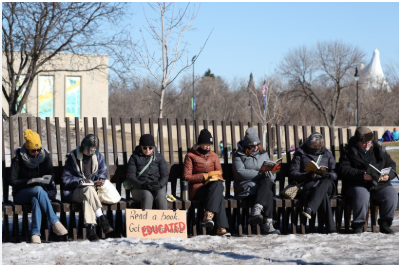Racism against Asian-Americans increasing

“Since the pandemic has started, I have heard stories of hate crimes committed against Asian-American people who I’m close with. A friend of mine described how her father had been verbally harassed, because he was Asian. Another family who is close to mine has reported several instances of verbal harassment due to their family’s race since the rise of Covid. It’s heartbreaking,” a Fargo North High student wrote in an anonymous survey.
Unfortunately, hate crimes against the Asian-American community have increased 150% nationally since the start of Covid, according to the New York Times. Unfortunately, not much legal action has been taken against it. This is because many hate crimes are not reported as such.
Don Lee, a community activist in New York, is frustrated by this, saying, “These are not random attacks. We’re asking for recognition that these crimes [hate crimes against Asian-Americans] are happening.”
However, it is difficult to prove that a crime is indeed a hate crime, rather than a crime that just happened to be committed against an Asian-American. Then, there are many hate crimes that go unreported, because of Asian-American’s reluctance to report the crime due to language barriers, worries that their immigration status will be questioned, fear of retaliation from perpetrators, or an unwillingness to make trouble, according to Stewart Loo, a deputy inspector who heads the Police Department’s Asian Hate Crimes Task Force. Also, some Asian-Americans are unwilling to report the crime if it is committed by a person of color, because they don’t want the perpetrator to be mistreated by the police.
About 50% of the Asian-Americans who took the Scroll’s anonymous survey reported that they feel less safe due to the increase in hate crimes. This shows the seriousness of this issue, especially given that Fargo, North Dakota, is not a place where physically harmful racist actions tend to occur.
One student acknowledged this writing, “[I do not feel less safe] in Fargo, but I would in other states.” Even before the pandemic, racial slurs and mocking of Asian-Americans’ accent and slanted eyes occurred.
However, with the onset of the pandemic, these non-violent offenses have increased.
One student wrote, “Someone said to me, ‘Oh aren’t you Asian?’ and then backed away from me as if I had a disease or something.”
Another student reported that someone had written, “Go home,” on their door.
Unfortunately, there has also been an increase in more serious crimes. Many students reported tire slashing incidents. This could end up costing the victim anywhere from $85 to $325, taking into account tire replacement and towing costs.
Another student wrote, “My mom is Chinese, and there have been a lot of incidents in America about Asian-Americans being killed. I now do not feel safe letting my mom go outside alone.”
With the increase in the number and seriousness of these hate crimes, one can’t help but wonder if the cause goes deeper than the fact that the Coronavirus originated in China. Some people believe that these anti-Asian sentiments were fueled by past President Donald Trump when he used terms such as the “Chinese-virus,” and the “Kung-flu.” Other students attribute it to racist beliefs towards Asian-Americans that have been around for years.
They wrote, “I think that there has been a lot of casually anti-Asian sentiment in the U.S. for a long time. However, because COVID-19 was reported to have originated in China, I think a lot of people felt “justified” in expressing that racism. People who say casually offensive things only fuel people who are more extreme, like those who have assaulted Asian-Americans during the pandemic.”
Other students believe it’s because people just need someone to blame. “People are scared of the world and they want someone to blame for their issues,” one student wrote.
Due to the severity of this issue, many people are searching for a solution. Unfortunately, one is not easily attainable. Some are advocating to lower the bar for hate-crime charges, toughen the penalty, and increase investigation towards attacks against Asian-Americans. However, others argue that this will disproportionately harm the Black and Latino communities due to their history of being victims of aggressive policing. Many students at Fargo North expressed hopelessness towards this situation, arguing that there is not much that can be done.
“I’ll be blunt, there is very little (if anything) that can be done to completely stop Asian hate. The history of America is also a history of hate against anyone that doesn’t fit a certain profile,” one student wrote.
However, they did end with the suggestion that greater education would be beneficial.
Other students shared this belief, writing, “Education [could help reduce Asian-American hate crimes]. Improved and inclusive education on not just Asian-American issues, but all issues pertaining to marginalized groups as a whole to make people more aware of it.”
Other students recognized how difficult it will be to solve racism.
One student wrote, “I think that this is a problem that is going to take generations to fix, because I don’t think everyone *suddenly* became racist against Asian people. I think that a lot of people have had dormant, socially unacceptable beliefs about Asian people for all their life. However, when the pandemic hit, it became more socially acceptable to speak and act on these stereotypes.”
Luckily, Congress is taking action against Asian-American hate. They are currently discussing a bill called the COVID-19 Hate Crimes Act. This bill would create a new position that would quicken the process of reviewing hate crime, ensure that hate crimes are reported by expanding public channels, and decrease discriminatory language when describing the pandemic. As of the writing of this article, this bill has yet to be voted on.
Hatred and racism against Asian-Americans are not going to go away overnight. However, the situation is not hopeless. There is so much that can be done to help. CNN offers many suggestions. For example, stopping racist comments both online and in-person can go a long way. Even something that is meant as a joke can be harmful. Although standing up against others can be intimidating, there are steps you can take to become more confident and experienced. This includes taking a free bystander intervention course offered through the anti-harassment group Hollaback.
Furthermore, supporting Asian-American businesses can be extremely helpful, especially because these businesses were hit the hardest due to xenophobia and discrimination. Finally, supporting the Asian American community on social media, supporting anti-racist groups, and supporting victims can go a long way. The bottom line is that there is so much each individual in this country can do to help. Although we do not have control over the racist actions of others, we still have so much power to help prevent these actions. Hopefully, our actions now can create a brighter, less racist future.
Your donation will support the student journalists of Fargo North High School. Your contribution will allow us to resume physical printing of our newspaper for students at Fargo North!

Laura Simmons is a writer for Fargo North High's Scroll. She takes Orchestra and Latin as well as Journalism for her electives. She is also active in multiple...


